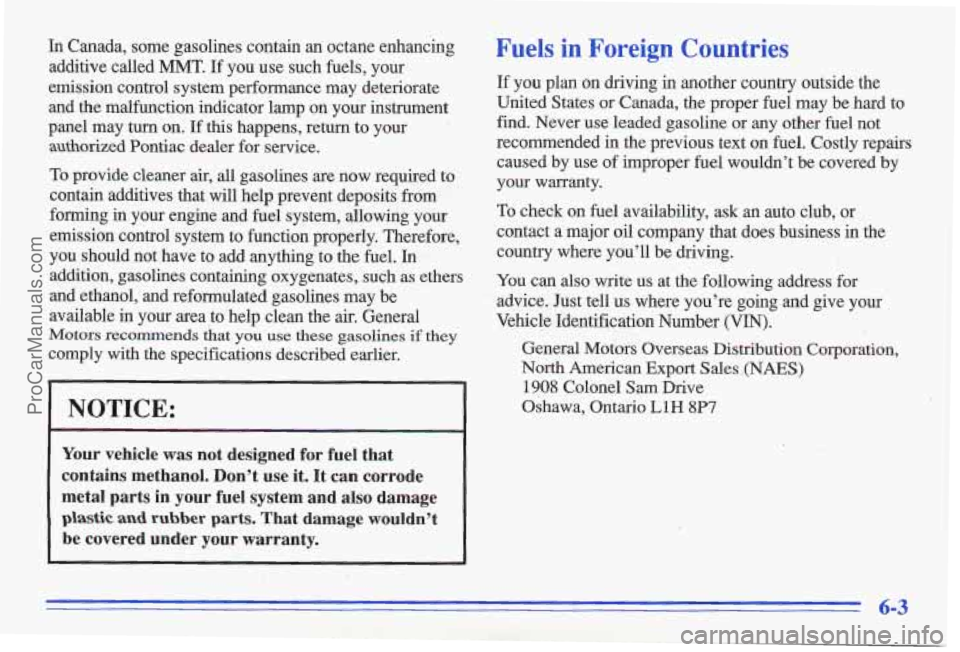Page 207 of 356
Adding only plain water to your cooling system
can be dangerous. 'Plain water, or
some other
liquid like alcohol, can boil before the proper
coolant
mix' will. Your vehicle's coolant warning
system is set
for the proper coolant mix. With
plain water
or the wroug mix, your engine could
get too hot but you wouldn't get the overheat
warning. Your engine could catch.fire and you
or
others could be burned. Use a 50150 mix of clean
water and
DEX-COOL TM antifreeze.
ProCarManuals.com
Page 215 of 356
NOTICE:
Raising your vehicle with the jack improperly
positioned will damage the vehicle or
may allow
the vehicle to fall off the jack. Be sure to fit the
jack lift head into the proper location before
raising your vehicle.
I NOTICE:
I
Do not jack or lift vehicle using the oil pan. Pans
could crack and begin to leak fluid. 4. Raise the vehicle by rotating the wheel wrench
clockwise. Raise the vehicle far enough off the
ground so there is enough room for the spare tire
to fit.
5. Remove all of the wheel nuts.
5-25
ProCarManuals.com
Page 217 of 356
I A CAUTION:
Never use oil or grease on studs or nuts. If you
do, the nuts might come loose. Your wheel could fall off, causing a serious accident.,
% '
j !. ', . , , ,.
8. Replace the wheel nuts
with the rounded end
o'f
the nuts toward the
wheel. Tighten each nut
by hand until the wheel
is held against the hub.
i L
9. Lower the vehicle by rotating the wheel wrench
counterclockwise. Lower the jack completely.
ProCarManuals.com
Page 225 of 356

In Canada, some gasolines contain an octane enhancing additive called MMT.
If you use such fuels, your
emission control system performance may deteriorate and the malfunction indicator lamp on your instrument
panel may turn
on. If this happens, return to your
authorized
Pontiac dealer for service.
To provide cleaner air, all gasolines are now required to
contain additives that will help prevent deposits from
forming in your engine and fuel system, allowing your
emission control system to function properly. Therefore,
you should not have to add anything to the fuel.
In
addition, gasolines containing oxygenates, such as ethers
and ethanol, and reformulated gasolines may be
available
in your area to help clean the air. General
Motors recommends that you use these gasolines if they
comply with the specifications described earlier.
NOTICE:
Your vehicle was not designed for fuel that
contains methanol. Don’t use it. It can corrode
metal parts in your fuel system and also damage
plastic and rubber parts. That damage wouldn’t
be covered under your warranty.
Fuels in Foreign Countries
If you plan on driving in another country outside the
United States or Canada, the proper fuel may be hard to
find. Never use leaded gasoline
or any other fuel not
recommended in the previous text on fuel. Costly repairs
caused by use of improper fuel wouldn’t be covered by
your warranty.
To check on fuel availability, ask an auto club, or
contact a major oil company .that does business
in the
country where you’ll be driving.
You can also write us at the following address for
advice. Just tell us where you’re going and give your
Vehicle Identification Number
(VIN).
General Motors Overseas Distribution Corporation,
North American Export Sales .(NAES)
1908 Colonel Sam Drive
Oshawa, Ontario
L1H 8P7
ProCarManuals.com
Page 228 of 356
NOTICE:
If you need a new cap, b'e sure to get the right
type.
Your dealer can get one for you. If you get
the wrong type, it may not fit or have proper
venting, and your fuel tank and emissions system
might be
damaged.
Things that burn can get on hot engine parts and
start
a fire. These include liquids like gasoline,
oil, coolant, brake fluid, windshield washer and
other fluids, and plastic
or rubber. You or others
could b'e burned. Be
careful not to drop or spill
things
that will burn onto a hot engine.
Checking "'lings Under the Hood
r
An electric fan under the hood can start up and
injure
you even when the engine is not running.
Keep hands, clothing and tools away from any
underhood electric
fan.
The following sections tell you how to check fluids,
lubricants and important parts underhood.
TO open the hood, first pull
the handle inside the
vehicle.
ProCarManuals.com
Page 230 of 356
2.4L (CODE T) Engine
When you open the hood, you’ll see:
Brake Fluid Reservoir
B. Engine Oil Fill Cap G. Windshield Washer Fluid Reservoir
C. Engine Oil Dipstick M. Hydraulic Clutch Fluid Reservoir (if so equipped)
D. Automatic Transaxle Dipstick (if equipped) I. Air Cleaner
E. Power Steering Fluid Reservoir J. Battery
6-8
ProCarManuals.com
Page 231 of 356
3.1L (CODE M) Engine
When you open the hood, ou’ll see:
A. Engine Coolant Surge Tank
B. Power Steering Fluid Reservoir
C. Engine Oil Fill Cap
D. Engine Oil Dipstick
E. Automatic Transaxle Fluid Dipstick
6-9
E Brake Fluid Reservoir
G. Windshield Washer Fluid Reservoir
H. Air Cleaner
I. Battery
ProCarManuals.com
Page 232 of 356
Engine Oil
CHECK
OIL
If the CHECK OIL light on
the instrument
panel comes
on,
it means you need to
check your engine oil level
right away. For more
information,
see “Check Oil
Light”
in the Index. You
should check your engine
oil
level regularly; this is an
added reminder.
It’s a good idea to check your engine oil every time you
get fuel. In order to get an accurate reading, the oil must 2.4L Engine
be warm and the vehicle must be on level ground.
6-10
k . 1
ProCarManuals.com